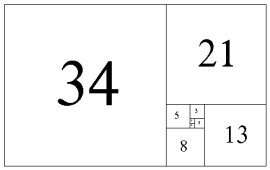A sequence of integer numbers that after its first two numbers each subsequent term is the sum of the previous two terms: Fn=Fn-1+Fn-2
. The sequence is then of course infinite. The first 10 terms of the sequence are:
0, 1, 1, 2, 3, 5, 8, 13, 21, 34
Now this in itself is not a very difficult or overly interesting/complex sequence. But the huge array of implications it has on the "real world" are incredibly interesting and in fact fascinating, if you're a nerd that is.
This is the Fibonacci tile, each square has the side length of what's in the middle of the square. Pretty but so what? Well, as all Mathematicians are, they weren't content with just turning a sequence into an array of squares and they looked deeper, don't they always? If you make a quarter circle from the tangents of each square and continue this way going through each square you end up with a spiral, obviously.
Oooh pretty, but big woop? Well yes, actually quite a massive big woop in fact. It is staggering how often either the Fibonacci spiral or sequence appears in nature. The branches of trees, arrangement of leaves, the flowering arrangements of certain flowers, the arrangement of a pine cone, the spiral of shells, the curvature of waves and even in family tree of bees, seriously. If you want to read about how the hell they're related please go here: http://en.wikipedia.org/wiki/Fibonacci_spiral#In_nature
Bees and the Fibonacci sequence, a match made in heaven. I'm waiting for my image to hit the papers, I'm pretty certain it will be voted the Scientific Breakthrough of the Year.
Other Random Facts:
Every positive integer can be wrote in a unique way as the of one or more Fibonacci terms and it will not include any two consecutive Fibonacci terms.
The Fibonacci Sequence can be used to determine tunings in music.
The Golden Ratio and Fibonacci Sequence are very, very closely related.




No comments:
Post a Comment